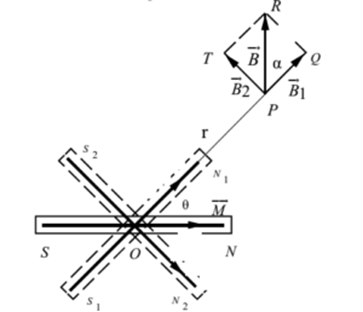Science > Physics > Magnetism > Magnetic Induction and Magnetic Potential at any Point
In this article, we shall study to derive an expression for magnetic induction and magnetic potential at any point in a magnetic field created by a bar magnet.
Magnetic Induction at Any Point Due to a Short Bar Magnet:

Consider a short magnetic dipole NS. Let be the magnetic moment of the dipole
M = m x 2l ………………(1)
The direction of magnetic induction is along the axis from S-pole to N-pole inside the magnet.
Consider a point ‘P’ near the dipole at distance ‘r’ from its centre O. i.e. OP = r Let ‘ θ’ be the angle between the line joining the point from the centre O and the axis of the dipole (angle between OP and SN). Resolving magnetic moment into two mutually perpendicular components, we have, the component M Cosθ along OP and M Sinθ perpendicular to OP.
Now, the point P lies on the axis of M Cosθ. Hence, the magnetic induction at, the axis point of M Cos θ is given by

Also, the given point P lies on the equatorial-line of component M Sin θ. Hence, the magnetic induction at the equatorial point of M Sin θ is given by

Let B1 and B2 be represented by sides PQ and PT of completed parallelogram PQRT. The diagonal PR represents the resultant magnetic induction in magnitude and direction.

This is the magnitude of the resultant induction B at point P.
Let ∝ be the angle made by the resultant B with the direction of OP

This is the angle made by B with OP. Hence, the total inclination of the resultant induction B with the axis of the dipole is ( θ + ∝ )
Special cases:
Case 1: If P is a point on the axis of the dipole, then θ = 0° or θ = 180° and Cos θ = ± 1

Case – 2: If P is a point on the equator of the dipole, then θ = 90° and Cos θ = 0

Magnetic Potential at Any Point Due to a Short Bar Magnet:
The magnetic potential at a point in a magnetic field is defined as the work done in moving unit north pole from infinity to that point. It is denoted by ‘V’ and its S.I. unit is J/Am or Wb/m.
In free space, the magnetic potential at a point due to the magnetic pole of strength ‘m’ units and at a distance, r is given by


Consider a short magnetic dipole NS. Let M be the magnetic moment of the dipole
M = m x 2l ………………(1)
The direction of M is along the axis from S-pole to N-pole.
Consider a point ‘P’ near the dipole at distance ‘r’ from its centre O. i.e. OP = r. Let ‘θ’ be the angle between the line joining the point from the centre O and the axis of the dipole (angle between OP and SN).
Now the magnetic potential due to the North Pole of a magnetic dipole is given by

The magnetic potential due to the North Pole of a magnetic dipole is given by

Since the magnetic potential is a scalar quantity, the resultant potential at a point P is given by



Case 1: If P is a point on the axis of the dipole, then θ = 0° or θ = 180° and Cos θ = ± 1

Case – 2: If P is a point on the equator of the dipole, then θ = 90° and Cos θ = 0
Hence Vequator = 0
One reply on “Magnetic Induction and Potential at any Point”
Thank you- clear and helpful pdf